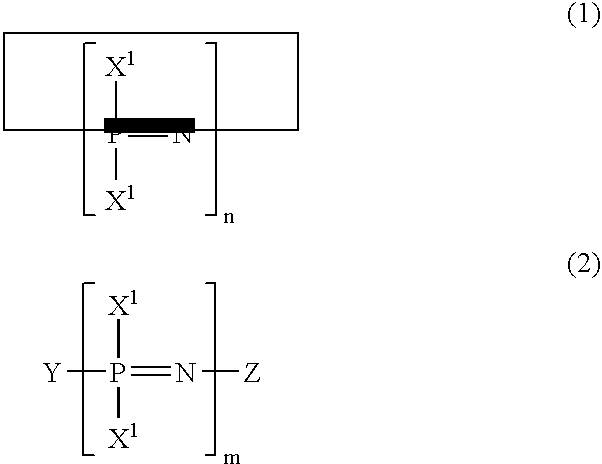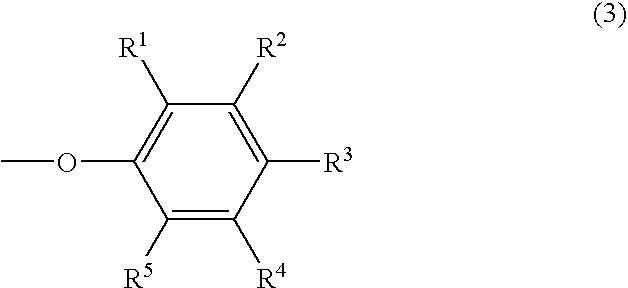Phosphazene composition
a technology of phosphazene and composition, which is applied in the field of phosphazene composition, can solve the problems of large quantity of phosphate esters and condensed phosphate esters, red phosphorus suffers from the problems of hydrolysis and corrosion of molds, and deterioration of mechanical properties and thermal properties, and achieves excellent moisture resistance, flame retardancy and stability of electric characteristics
- Summary
- Abstract
- Description
- Claims
- Application Information
AI Technical Summary
Benefits of technology
Problems solved by technology
Method used
Image
Examples
example 1
[0105]FR1: 160.2 g of phenol, 112.2 g of solid potassium hydroxide and 500 ml of xylene were charged in a 2 L four-necked flask equipped with Dean Stark tube with a Dimroth condenser tube, a dropping funnel, a thermometer, and a stirrer, and refluxed with heating at an oil bath temperature of 145° C. in a nitrogen stream. Water produced was taken out of the system by azeotropy with xylene, and only the xylene was returned to the system. Refluxing with heating was carried out until distillation of the produced water terminated. Completion of the reaction required 4 hours.
[0106]The reaction vessel was dipped in an ice bath and cooled until the reaction mixture reached 10° C. or lower, and then a mixed solution of 72.1 g of chlorophosphazene oligomer (trimer: 95%, tetramer: 4%, other components: 1%) and 250 ml of xylene was added dropwise to the reaction mixture over a period of 30 minutes using the dropping funnel while keeping the reaction mixture at 10° C. or lower. After the additi...
example 2
[0107]FR2: 151.5 g of phenol, 103.6 g of solid potassium hydroxide and 500 ml of xylene were charged into a 2 L four-necked flask equipped with Dean Stark tube, with a Dimroth condenser tube, a dropping funnel, a thermometer, and a stirrer, and refluxed with heating at an oil bath temperature of 145° C. in a nitrogen stream. Water produced was taken out of the system by azeotropy with xylene, and only the xylene was returned to the system. Refluxing with heating was carried out until distillation of the produced water terminated. Completion of the reaction required 4 hours.
[0108]The reaction vessel was dipped in an ice bath and cooled until the reaction mixture reached 10° C. or lower, and then a mixed solution of 70.0 g of chlorophosphazene oligomer and 250 ml of xylene was added dropwise to the reaction mixture over a period of 30 minutes using the dropping funnel while keeping the reaction mixture at 10° C. or lower. After the addition of the mixed solution, the reaction mixture ...
example 3
[0109]FR3: 158.0 g of phenol, 110.0 g of solid potassium hydroxide and 500 ml of chlorobenzene were charged in a 2 L four-necked flask equipped with Dean Stark tube with a Dimroth condenser tube, a dropping funnel, a thermometer, and a stirrer, and refluxed with heating at an oil bath temperature of 145° C. in a nitrogen stream. Water produced was taken out of the system by azeotropy with chlorobenzene, and only the chlorobenzene was returned to the system. The refluxing with heating was carried out until distillation of the produced water terminated. Completion of the reaction required 6 hours.
[0110]The reaction vessel was dipped in an ice bath and cooled until the reaction mixture reached 10° C. or lower, and then a mixed solution of 72.1 g of chlorophosphazene oligomer and 250 ml of chlorobenzene was added dropwise to the reaction mixture over a period of 30 minutes using the dropping funnel while keeping the reaction mixture at 10° C. or lower. After the addition of the mixed so...
PUM
| Property | Measurement | Unit |
|---|---|---|
| temperature | aaaaa | aaaaa |
| temperature | aaaaa | aaaaa |
| temperature | aaaaa | aaaaa |
Abstract
Description
Claims
Application Information
 Login to View More
Login to View More - R&D
- Intellectual Property
- Life Sciences
- Materials
- Tech Scout
- Unparalleled Data Quality
- Higher Quality Content
- 60% Fewer Hallucinations
Browse by: Latest US Patents, China's latest patents, Technical Efficacy Thesaurus, Application Domain, Technology Topic, Popular Technical Reports.
© 2025 PatSnap. All rights reserved.Legal|Privacy policy|Modern Slavery Act Transparency Statement|Sitemap|About US| Contact US: help@patsnap.com



